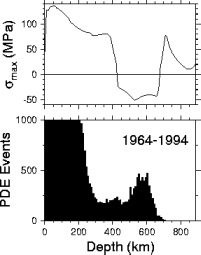1997a OHP Abstract
Bina, C. R.,
Seismogenic stresses from phase transitions,
Abstracts of the Ocean Hemisphere Project (OHP) International Symposium
on New Images of the Earth's Interior through Long-term Ocean-floor
Observations, Kazusa Akademia Center, Chiba Prefecture, Japan,
84, 1997.
The distinctive features of deep earthquakes - such as down-dip
compressional focal mechanisms, normal depth-distribution of seismicity
about ~550-600 km, and abrupt cessation at ~690 km depth -
presumably reflect either stresses present in subducting lithospheric
slabs, failure mechanisms responsible for releasing these stresses,
or some combination of both.
Buoyancy forces - due to the negative thermal buoyancy of the slab
and due to density anomalies arising from thermal perturbation of
mantle phase relations - provide important contributions to slab
stresses.
The thermal field of a subducting slab perturbs equilibrium mantle
phase relations among high-pressure olivine polymorphs, yielding
negative buoyancy anomalies associated with alpha-beta-gamma
interactions and a positive anomaly associated with gamma-pv-mw
interaction.
Finite element modeling of the resulting buoyancy forces reveals a
stress transition from principal tension to compression near ~400 km
depth, down-dip compression over ~400-690 km (peaking near
~550 km), and reversion to rapidly fading tension below
~690 km, consistent with observed patterns of deep seismicity
(Figure 1).
Consideration of possible metastable persistence of lower pressure
phases within the cold slab introduces additional fine structure
into the stress patterns.
The fact that such a simple model, which neglects all effects other
than buoyancy anomalies, can successfully generate so many observed
features of deep seismicity suggests that such buoyancy forces
contribute significantly to the stress field in subducting slabs.
Moreover, it indicates that the observed depth-distribution of deep
seismicity may primarily reflect the state of stress in the subducting
slab rather than a particular mechanism of seismogenic stress release.
 Figure 1:
Top: magnitude (negative is compressive) of (absolute) maximum
principal stress, sigma_max, profiled down-dip along slab temperature
minimum, computed from buoyancy forces arising from olivine equilibrium
phase relations in slab thermal field.
Bottom: depth distribution of global seismicity for period 1964-1994.
Figure 1:
Top: magnitude (negative is compressive) of (absolute) maximum
principal stress, sigma_max, profiled down-dip along slab temperature
minimum, computed from buoyancy forces arising from olivine equilibrium
phase relations in slab thermal field.
Bottom: depth distribution of global seismicity for period 1964-1994.
Copyright © 1997 Craig R. Bina
Return to Craig's conference abstracts
page.
Go to Craig's home page.
Copyright © 1997 Craig R. Bina.
 Figure 1:
Top: magnitude (negative is compressive) of (absolute) maximum
principal stress, sigma_max, profiled down-dip along slab temperature
minimum, computed from buoyancy forces arising from olivine equilibrium
phase relations in slab thermal field.
Bottom: depth distribution of global seismicity for period 1964-1994.
Figure 1:
Top: magnitude (negative is compressive) of (absolute) maximum
principal stress, sigma_max, profiled down-dip along slab temperature
minimum, computed from buoyancy forces arising from olivine equilibrium
phase relations in slab thermal field.
Bottom: depth distribution of global seismicity for period 1964-1994.